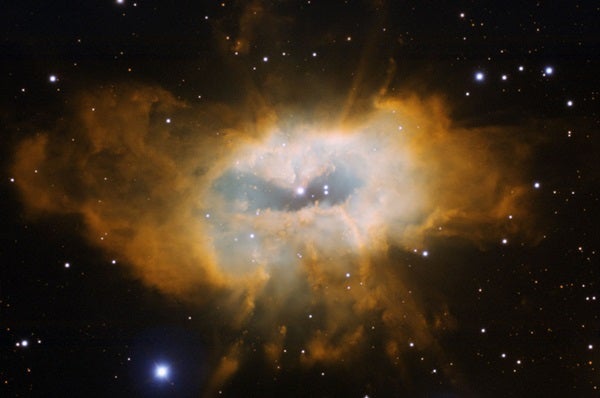Take this new Gemini Legacy image of the elaborate planetary nebula Sharpless 2–71. For most of its recorded history, astronomers assumed that it formed from the death throes of an obvious bright star — a known binary system — near its center. Arguments against that claim, however, have turned this case into a classic mystery of uncertain parentage.
The Gemini Legacy image shows the long-assumed central star shining as the brightest object close to the center of the nebula’s beautiful gas shell. But new observations have shown that the nature of a dimmer, bluer star — just to the right, and a bit lower than the obvious central star — might provide a better fit for the nebula’s “birth parent.”
The uncertainty arises from the fact that the brighter central star doesn’t appear to radiate enough high-energy (ultraviolet) light to cause the surrounding gas to glow as intensely as it does, whereas the dimmer, bluer star likely does. On the other hand, the brighter star’s binary nature would help explain the nebula’s asymmetrical structure. Astronomers do not yet know if the dimmer, bluer star also has a companion.
Another unresolved issue is whether the brighter star’s unseen companion might be hot enough to excite the gas to glow. If so, this pair might be able to hold on to its parental connection to the nebula.
A research team, led by Australian astronomers David Frew and Quentin Parker from Macquarie University, Sydney, is studying the dimmer, bluer star to understand its nature. “At the assumed distance to the nebula — roughly 1 kiloparsec, or about 3,260 light-years — the faint star has about the right brightness to be the fading remnant of the nebula’s progenitor star,” said Frew.
Then again, the brighter binary star is an uncommon one that shows strong and broad Hydrogen-alpha emission, which are seen in some planetary nebulae. According to Frew, this star also is unlikely to be a chance projection or alignment with the nebula, “so there could be at least three stars in this system,” he said.
Putting aside the complex issue of which star or stars formed this object, the nebula’s striking morphology also poses difficult questions. “The nebula presents a multipolar structure and several pairs of bipolar lobes at different orientations,” said Luis Miranda from Spain’s Institute of Astrophysics of Andalucía, who has also studied this object extensively. “These lobes most certainly formed at different times and likely involved a binary progenitor — in particular with mass-transfer and multiple episodes of mass ejection along an axis where the orientation changes with time.”
Adding to the puzzle, Parker and Romano Corradi from the Institute of Astrophysics of the Canary Islands, Spain, have recently discovered faint outer wisps and lobes surrounding the planetary on deep Hydrogen-alpha images taken as part of the Isaac Newton Telescope Photometric HydrogenAlpha Survey of the Northern Galactic Plane Survey. These features extend over many arcminutes — not shown in the new Gemini image — suggesting the mass-loss history of this object has even more levels of complexity.
Miranda agrees, noting that the nebula’s structure is difficult to explain without a binary pair for parents. “The chaotic morphology of Sh 2–71 implies that very complex processes have been involved in its formation,” said Miranda. Unfortunately, not much is known about either possible central star’s known or speculated companions. So the mystery of the nebula’s uncertain parentage remains unsolved … for now.










